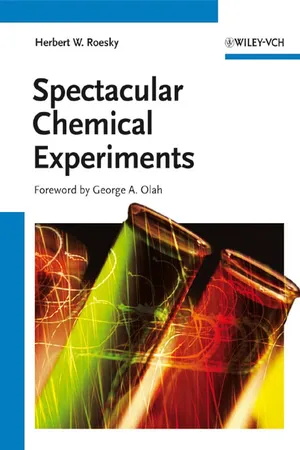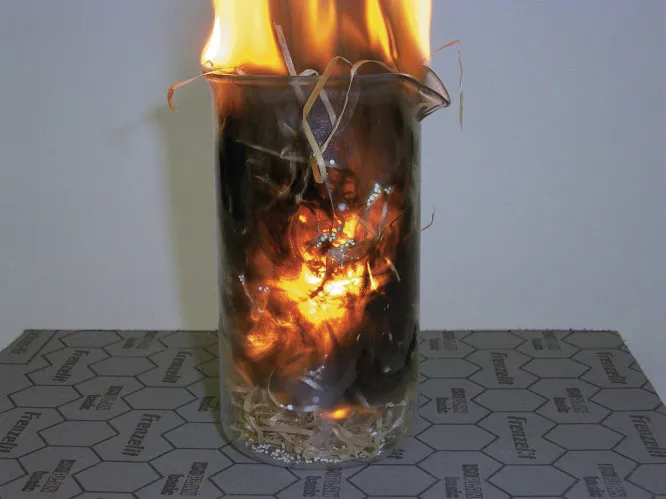
This is a test
- English
- ePUB (mobile friendly)
- Available on iOS & Android
eBook - ePub
Spectacular Chemical Experiments
Book details
Book preview
Table of contents
Citations
About This Book
Written by the author of the award-winning "Chemische Kabinettstücke" this book demonstrates over 80 enjoyable, impressive and sometimes almost unbelievable chemical experiments for the classroom, lecture hall or home. All the experiments are explained in full, and have been tested several times such that their successful reproduction is guaranteed.
Grouped into several cycles -- water, the color blue, the color red, soles, and self-organization -- the topics are perfect for experimental lectures or school projects. Detailed illustrations and the lively writing style make this book equally attractive to readers interested in chemistry, even if they are unable to perform the experiments.
Frequently asked questions
At the moment all of our mobile-responsive ePub books are available to download via the app. Most of our PDFs are also available to download and we're working on making the final remaining ones downloadable now. Learn more here.
Both plans give you full access to the library and all of Perlego’s features. The only differences are the price and subscription period: With the annual plan you’ll save around 30% compared to 12 months on the monthly plan.
We are an online textbook subscription service, where you can get access to an entire online library for less than the price of a single book per month. With over 1 million books across 1000+ topics, we’ve got you covered! Learn more here.
Look out for the read-aloud symbol on your next book to see if you can listen to it. The read-aloud tool reads text aloud for you, highlighting the text as it is being read. You can pause it, speed it up and slow it down. Learn more here.
Yes, you can access Spectacular Chemical Experiments by Herbert W. Roesky in PDF and/or ePUB format, as well as other popular books in Physical Sciences & Inorganic Chemistry. We have over one million books available in our catalogue for you to explore.
Information
Part I
Water
I don’t know who discovered water, but it probably wasn’t a fish.Herbert Marshall McLuhanFrom heaven it comes,To heaven it goes,And down againTo the earthEndlessly changing.Ferdinand Fischer
Water is one of Aristotle’s four elements. Thales described it as the only true element from which all the other materials originate. Today, we know that without water, life and evolution are impossible.
This is true even at the beginning of the 21st century. Europe and the United States are competing to discover if there is human habitation on Mars (Beagle 2 and Spirit). In the solar system, Mars is much more like Earth, and scientists consider that, some 3.5 billion years ago, today’s icy planet was warm and humid. Although there is always water on Mars, it exists as a more or less thick layer of ice.
Water is vital both inside and outside the human body.
The water percentage in the human body:
| Age | Water content (%) |
| Day of birth | 79 |
| 5 years | 2 |
| 16 years | 58 |
| Adult | |
| Normal weight | 62 |
| Very slim | 69 |
| Very fat | 42 |
The water percentage inside the different organs:
| Organ | Water content (%) |
| Eyeball | 99 |
| Brain | 84 |
| Heart | 74 |
| Liver | 72 |
| Bones | 55 |
| Hair | 4 |
| Teeth | 0.2 |
Inside the human body, water transports dissolved materials to the different organs and the cells, and it also serves to maintain the functions of the cells. Water is also necessary for the digestion of food and the transportation of its components.
Water is not always drinking water; the oceans, for example, contain 4% of salt which is mostly sodium chloride. Shipwrecked persons who drink water with such a high salt content can survive for only a short period of time.
Water is a very good solvent. In fact, drinking water contains almost every soluble material with which it comes into contact. However, only 0.27% of all of the water on Earth can be used as drinking water.
Experiment 1
Spontaneous Ignition by Adding Water
Whoever is ignorantof the elements,of the strength they wieldand of their qualityCannot masterThe band of the spirits.Johann Wolfgang von Goethe
Apparatus
A fire-proof support, one 250-mL beaker, one wash-bottle, safety glasses, protective gloves.
Chemicals
Wood shavings, Na2O2, water (or champagne, beer, etc.).
Attention!
Na2O2 reacts almost like sodium spontaneously with water. Na2O2 and hydrogen peroxide can cause burns, and skin contact must be avoided. Do not scale up the amount of Na2O2. Safety glasses and protective gloves must be used at all times.
Experimental Procedure
The wood shavings are loosely filled into the beaker and the latter is placed on the fire-resistant support. Before starting the experiment, 0.4 g of Na2O2 is placed on the wood shavings and immediately a few drops of water are added. The water reacts spontaneously with the Na2O2, and the wood shavings start to burn. In most of cases, the beaker cracks.
Explanation
Na2O2 is a strong oxidizer and reacts very often explosively with unsaturated organic compounds under incandescence. In the presence of small amounts of water, Na2O2 reacts under the elimination of oxygen:

The NaOH reacts catalytically under decomposition of the intermediately formed H2O2. However, at low temperatures Na2O2 reacts with water under formation of NaOH and H2O2:


Experiment 1: A beaker with burning wood shavings and sodium peroxide.
Experiment 2
Blowing-Up an Iron Ball
We ourselves are the measure of the miraculous, when we would look for a general measure, then the miraculous would disappear, and everything would have the same size.Georg Christoph Lichtenberg
Apparatus
An iron ball equipped with a screw lock (Phywe Göttingen), one PVC trough (30cm in diameter and 15cm inside height), safety glasses, protective gloves.
Chemicals
Wet ice, salt for the cooling bath, ice water.
Attention!
Safety glasses and protective gloves must be used at all times.
Experimental Procedure
The iron ball is filled with ice water and the screw lock is tightly closed. The iron ball is then placed in the already prepared freezing mixture (ice and sodium chloride). After about 20–30 minutes, the iron ball ruptures u...
Table of contents
- Cover
- Table of Contents
- Series Page
- Title
- The Author
- Copyright
- Foreword
- Preface
- Part I: Water
- Part II: The Color Blue
- Part III: The Color Red
- Part IV: Colloids, Sols, and Gels
- Part V: Fascinating Experiments by Self-Organization
- Part VI: Chemical Varieties
- Part VII: The Art Gallery of Chemistry
- Conclusion
- Index
- End User License Agreement